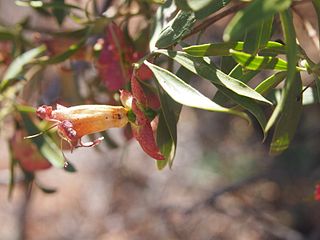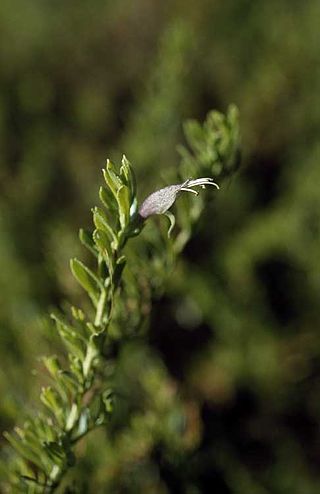Eremophila coacta is a flowering plant in the figwort family, Scrophulariaceae and is endemic to a small area in the north west of Western Australia. It is an erect shrub with narrow, sticky, pointed leaves and densely hairy light to dark lilac-coloured flowers.
Eremophila conglomerata is a flowering plant in the figwort family, Scrophulariaceae and is endemic to central areas of Western Australia. It is an erect shrub with small, serrated leaves and mauve to blue flowers that extend well beyond the foliage.
Eremophila cryptothrix is a flowering plant in the figwort family, Scrophulariaceae and is endemic to the Pilbara region of Western Australia. It is a shrub with sticky stems due to the presence of resin, narrow leaves, coloured sepals and white, pale pink or pale blue flowers.
Eremophila falcata is a flowering plant in the figwort family, Scrophulariaceae and is endemic to Western Australia. It is a widely distributed shrub with distinctive curved leaves and white, lilac-coloured or pink flowers.

Eremophila flabellata is a flowering plant in the figwort family, Scrophulariaceae and is endemic to Western Australia. It is a small shrub with serrated leaves, broad serrated sepals and pink, purple or mauve flowers.

Eremophila galeata is a flowering plant in the figwort family, Scrophulariaceae and is endemic to Western Australia. It is a shrub with sticky, shiny leaves, unusual sepals, a dull pink and brown, spotted petal tube and which grows in stony red soils.

Eremophila goodwinii, commonly known purple fuchsia bush and Goodwin's emu bush is a flowering plant in the figwort family, Scrophulariaceae and is endemic to Australia. It is a small, spreading or erect shrub with most parts sticky due to the presence of resin, tapering leaves and pale lilac to mauve flowers. It occurs in New South Wales, the Northern Territory and Queensland.
Eremophila humilis is a flowering plant in the figwort family, Scrophulariaceae and is endemic to Western Australia. It is a low, rounded shrub with club-shaped leaves and white bell-shaped flowers and which is only found in a restricted area near Meekatharra.

Eremophila incisa is a flowering plant in the figwort family, Scrophulariaceae and is endemic to Western Australia. It is a low shrub with shiny leaves which have thickened teeth along their edges and hairy, mauve or purple flowers.

Eremophila neglecta is a flowering plant in the figwort family, Scrophulariaceae and is endemic to Australia. It is a shrub which branches from ground level and which has lance-shaped leaves and orange-red flowers. It occurs in South Australia and the Northern Territory.
Eremophila papillata is a flowering plant in the figwort family, Scrophulariaceae and is endemic to Western Australia. It is an erect, compact shrub with sticky, narrow leaves and mauve, blue or purple, rarely white flowers.
Eremophila pendulina is a flowering plant in the figwort family, Scrophulariaceae and is endemic to Western Australia. It is a tall, spindly, weeping shrub with narrow leaves and purple, mauve or white flowers in autumn and early spring.
Eremophila petrophila is a flowering plant in the figwort family, Scrophulariaceae and is endemic to Western Australia. It is a tall, erect, open shrub with rough branches, narrow, sticky leaves and pale lilac-coloured flowers.
Eremophila praecox is a flowering plant in the figwort family, Scrophulariaceae and is endemic to Australia. It is a small, broom-like shrub with small leaves and purple and white flowers.

Eremophila pungens is a flowering plant in the figwort family, Scrophulariaceae and is endemic to Australia. It is an erect, sticky shrub with broad, serrated-edged leaves which end in a sharp spine and purple or violet flowers.

Eremophila purpurascens, commonly known as purple eremophila, is a flowering plant in the figwort family, Scrophulariaceae and is endemic to Western Australia. It is an erect, bushy shrub with warty leaves and spotted, pink to red flowers.

Eremophila ramiflora is a flowering plant in the figwort family, Scrophulariaceae and is endemic to Western Australia. It is a shrub with sticky branches, broad, sticky leaves and deep red flowers which appear in successive flowerings.

Eremophila spuria is a flowering plant in the figwort family, Scrophulariaceae and is endemic to Western Australia. It is an erect, open shrub with narrow leaves and blue, lilac, purple or white flowers and is a common and widespread species.
Eremophila succinea is a flowering plant in the figwort family, Scrophulariaceae and is endemic to Western Australia. It is an erect, broom-shaped shrub with sticky, narrow, hooked leaves, narrow, sticky sepals and hairy, pale purple or mauve petals.

Eremophila veneta, commonly known as metallic-flowered eremophila is a flowering plant in the figwort family, Scrophulariaceae and is endemic to Western Australia. It is a low, spreading, sticky shrub with dark green leaves and bluish-green petals.











